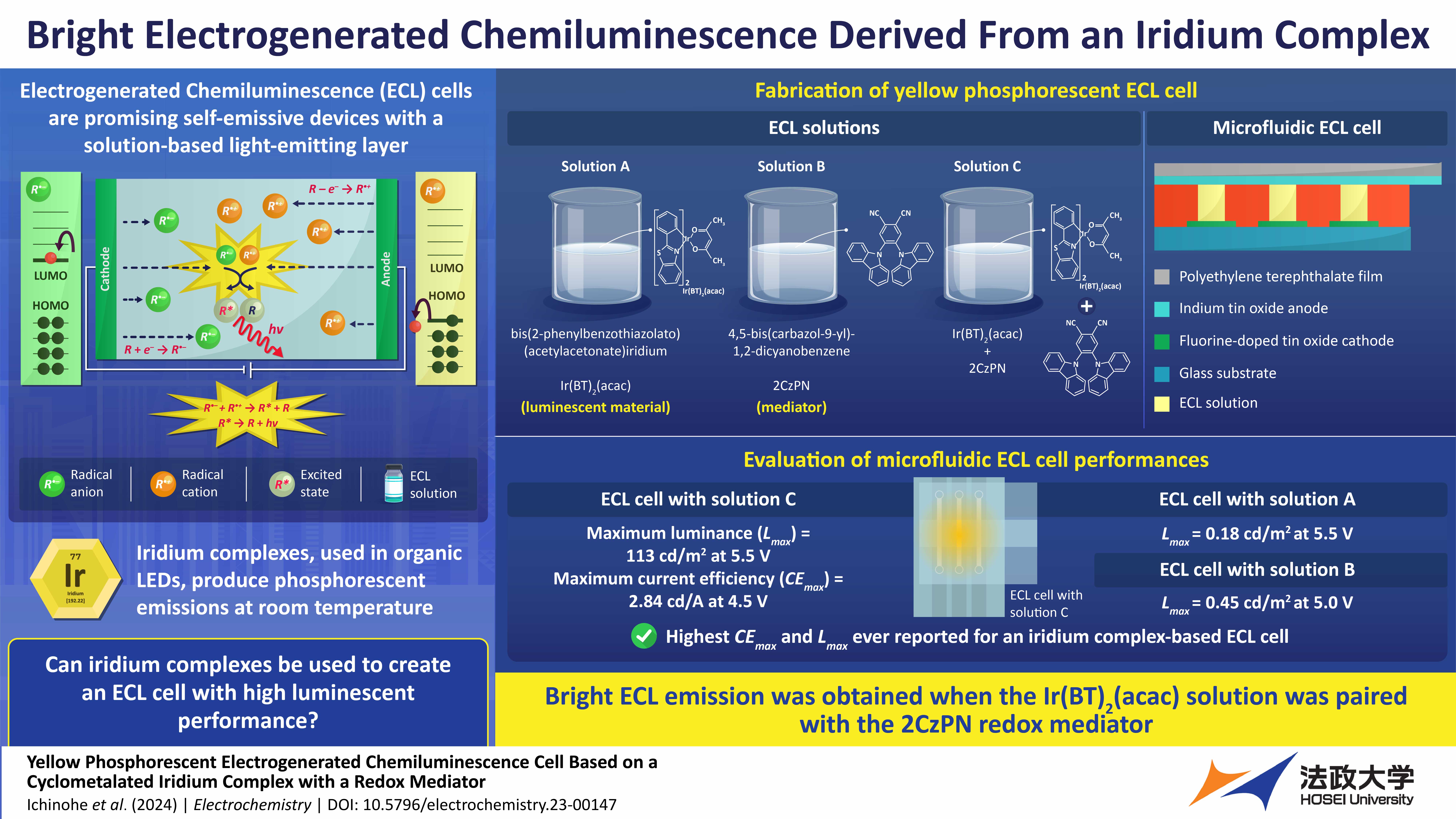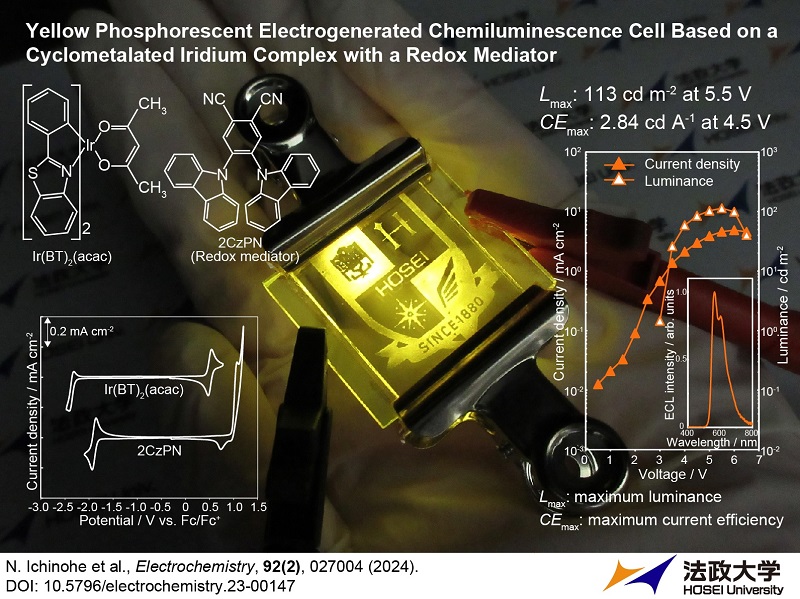News & Event
PRESS RELEASE: Enhancing Electrogenerated Chemiluminescence of an Iridium Complex
Researchers develop electrogenerated chemiluminescence cells that possess unprecedented levels of luminance and current efficiency.
Electrogenerated chemiluminescence (ECL) cells are inherently self-emissive and hold promise for next generation displays due to their simplicity of design and production. However, they trail behind light-emitting diodes (LEDs) and organic LEDs in luminance. Now, researchers have engineered yellow phosphorescent ECL cells with an iridium complex and a redox mediator, achieving the highest reported luminance and current efficiency for iridium complex-based cells. This advancement holds great promise for the future development of high-performance ECL-based displays.

Towards novel ECL cells
Caption: Scientists have enhanced the ECL cell performances using an iridium complex and a redox mediator in a significant step toward the development of next-generation displays.
Credit: Takashi Kasahara from Hosei University
License: Original Content
Electrogenerated chemiluminescence (ECL) cells, characterized by their self-emissive nature, have gathered significant interest for prospective display applications due to their uncomplicated structure and straightforward fabrication process. These cells are created by sandwiching a solution-based emitting layer between two transparent electrodes. Nevertheless, when compared to other self-emissive devices like light-emitting diodes (LED) and organic LEDs, the luminescent performance of ECL cells remains subpar and is currently undergoing improvement.
In contrast, iridium complexes are widely used in efficient organic LEDs due to their ability to produce room-temperature phosphorescent emissions from their excited states. The emission colors can be easily adjusted by changing ligands, and researchers have explored their properties using both theoretical and experimental methods.
In a recent study led by Associate Professor Takashi Kasahara and Nanami Ichinohe, a master’s student at Hosei University, and including collaborators from University of Fukui and National Cheng Kung University, researchers have successfully designed a highly luminescent ECL cell by utilizing an iridium complex and a mediator. This study has been published in the journal Electrochemistry on 15 February 2024.
According to Dr. Kasahara, “ECL is a light-emitting phenomenon induced by an electron transfer reaction between the radical anion and cation of the luminescent material. Although conventional ECL solutions have been typically prepared by dissolving specific amounts of a single luminescent material in an organic solvent, in this study we have prepared a solution that contained two luminescent materials.”
The two luminescent materials employed in the study were a yellow phosphorescent iridium complex (Ir(BT)2(acac)) and a sky-blue thermally activated delayed fluorescent (TADF) material, labeled as 2CzPN, serving as a redox mediator. For the experimental setup, three variations of ECL solutions were created and assessed using microfluidic cells developed by the research team. Among these solutions, two exclusively contained the iridium complex and the mediator, while the third incorporated both components.
The microfluidic ECL cell, incorporating both components, showcased a vivid yellow ECL emission arising from an electron transfer reaction between the radical cation of Ir(BT)2(acac) and the radical anion of 2CzPN. It was seen to achieve a peak luminance exceeding 100 cd m−2 and a maximum current efficiency of 2.84 cd A−1. These values represent the highest values reported for ECL cells based on an iridium complex. Notably, the luminance of this cell exceeded that of the ECL cell without 2CzPN by more than two orders of magnitude. In 2023, the authors have also improved the luminescent performances of the yellow fluorescent ECL cell by using the mediator (Electrochemistry, 91(4), 047002 (2023)). This led the authors to conclude that the developed ECL system applies not only to fluorescent materials but also to phosphorescent materials.
“We expect that this ECL system using the redox mediator will be actively investigated by many research groups across the world and contribute to future (in probably several decades from now), highly luminescent and efficient solution-based self-emissive display applications,” envisions Dr. Kasahara.
In summary, researchers have successfully engineered a yellow phosphorescent ECL cell incorporating an iridium complex and a redox mediator. This cell exhibits the highest luminance ever reported for iridium complex-based cells and is expected to pave the way for the development of next-generation ECL-based displays!

Iridium complex-mediator duo elevates self-emission
Caption: Scientists have enhanced the ECL cell performances, with a yellow phosphorescent iridium complex and a redox mediator, resulting in record levels of luminance and current efficiency.
Credit: Electrochemistry https://doi.org/10.5796/electrochemistry.23-00147
License: CC BY 4.0
Reference
Authors: Nanami Ichinohe1, Ryohei Otsuka1, Ryoichi Ishimatsu2, Manaka Kobayashi1, Jun Mizuno3, Nobuhiko Akino4, and Takashi Kasahara1
Title of original paper: Yellow Phosphorescent Electrogenerated Chemiluminescence Cell Based on a Cyclometalated Iridium Complex with a Redox Mediator
Journal: Electrochemistry
Year/Volume/pages: 2024 Volume 92 Issue 2 Pages 027004
DOI: 10.5796/electrochemistry.23-00147
Affiliations:
1. Department of Electrical and Electronic Engineering, Hosei University
2. Department of Applied Physics, University of Fukui
3. Academy of Innovative Semiconductor and Sustainable Manufacturing, National Cheng Kung University
4. Department of Computer Science, Hosei University
About Associate Professor Takashi Kasahara
Takashi Kasahara is an Associate Professor in the Department of Electrical and Electronic Engineering, Faculty of Science and Engineering at Hosei University, Japan. Before joining the university, he was associated with the Seiko Epson Corporation. With over 50 research papers (29 Articles and 21 Conference papers) and 529 citations. Assoc. Prof. Kasahara's research centers around nanotechnology, microfluidic engineering, microfabrication, electrogenerated chemiluminescence, and organic light-emitting devices. He earned his Ph.D. from Waseda University in 2015. Additionally, he has authored several books on organic electronic materials.
About Hosei University
Hosei University is one of the leading private universities in Tokyo, Japan. The university offers international courses in many disciplines and has a long and rich history. Hosei University was founded as a school of Law in 1880 and evolved into a private university by 1920.
It is also home to multiple research centers, which conduct advanced research on various fields, including nanotechnology, sustainability, ecology, and more.
The university has three main campuses—Ichigaya, Tama and Koganei, located across Tokyo.
For more information please see: https://www.hosei.ac.jp/english/
Media Contact
Office of the President Public Relations Section, Hosei University
pr@adm.hosei.ac.jp

